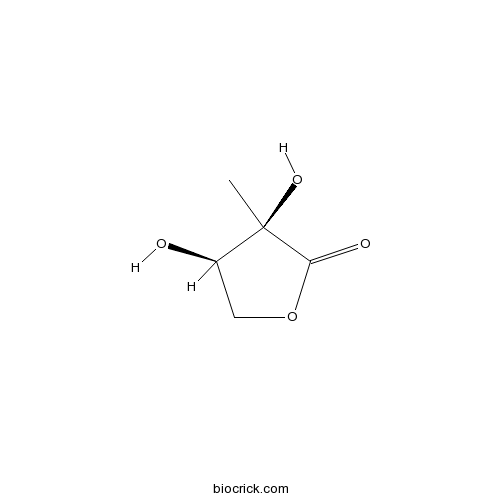2-C-Methyl-D-erythrono-1,4-lactoneCAS# 18465-71-9 |

Quality Control & MSDS
3D structure
Package In Stock
Number of papers citing our products

| Cas No. | 18465-71-9 | SDF | Download SDF |
| PubChem ID | 11126294 | Appearance | Oil |
| Formula | C5H8O4 | M.Wt | 132.1 |
| Type of Compound | Miscellaneous | Storage | Desiccate at -20°C |
| Solubility | Soluble in Chloroform,Dichloromethane,Ethyl Acetate,DMSO,Acetone,etc. | ||
| Chemical Name | (3R,4R)-3,4-dihydroxy-3-methyloxolan-2-one | ||
| SMILES | CC1(C(COC1=O)O)O | ||
| Standard InChIKey | OHTGZAWPVDWARE-NQXXGFSBSA-N | ||
| General tips | For obtaining a higher solubility , please warm the tube at 37 ℃ and shake it in the ultrasonic bath for a while.Stock solution can be stored below -20℃ for several months. We recommend that you prepare and use the solution on the same day. However, if the test schedule requires, the stock solutions can be prepared in advance, and the stock solution must be sealed and stored below -20℃. In general, the stock solution can be kept for several months. Before use, we recommend that you leave the vial at room temperature for at least an hour before opening it. |
||
| About Packaging | 1. The packaging of the product may be reversed during transportation, cause the high purity compounds to adhere to the neck or cap of the vial.Take the vail out of its packaging and shake gently until the compounds fall to the bottom of the vial. 2. For liquid products, please centrifuge at 500xg to gather the liquid to the bottom of the vial. 3. Try to avoid loss or contamination during the experiment. |
||
| Shipping Condition | Packaging according to customer requirements(5mg, 10mg, 20mg and more). Ship via FedEx, DHL, UPS, EMS or other couriers with RT, or blue ice upon request. | ||
| Description | 1. (-)-2-C-Methyl-D-erythrono-1,4-lactone is inactive alone, but elicits oviposition behavior when mixes with other fractions. |

2-C-Methyl-D-erythrono-1,4-lactone Dilution Calculator

2-C-Methyl-D-erythrono-1,4-lactone Molarity Calculator
| 1 mg | 5 mg | 10 mg | 20 mg | 25 mg | |
| 1 mM | 7.57 mL | 37.8501 mL | 75.7002 mL | 151.4005 mL | 189.2506 mL |
| 5 mM | 1.514 mL | 7.57 mL | 15.14 mL | 30.2801 mL | 37.8501 mL |
| 10 mM | 0.757 mL | 3.785 mL | 7.57 mL | 15.14 mL | 18.9251 mL |
| 50 mM | 0.1514 mL | 0.757 mL | 1.514 mL | 3.028 mL | 3.785 mL |
| 100 mM | 0.0757 mL | 0.3785 mL | 0.757 mL | 1.514 mL | 1.8925 mL |
| * Note: If you are in the process of experiment, it's necessary to make the dilution ratios of the samples. The dilution data above is only for reference. Normally, it's can get a better solubility within lower of Concentrations. | |||||

Calcutta University

University of Minnesota

University of Maryland School of Medicine

University of Illinois at Chicago

The Ohio State University

University of Zurich

Harvard University

Colorado State University

Auburn University

Yale University

Worcester Polytechnic Institute

Washington State University

Stanford University

University of Leipzig

Universidade da Beira Interior

The Institute of Cancer Research

Heidelberg University

University of Amsterdam

University of Auckland

TsingHua University

The University of Michigan

Miami University

DRURY University

Jilin University

Fudan University

Wuhan University

Sun Yat-sen University

Universite de Paris

Deemed University

Auckland University

The University of Tokyo

Korea University
- Nigracin
Catalog No.:BCN1152
CAS No.:18463-25-7
- Ethyl Coumarin-3-Carboxylate
Catalog No.:BCC9228
CAS No.:1846-76-0
- Mangostanol
Catalog No.:BCN1151
CAS No.:184587-72-2
- ROS 234 dioxalate
Catalog No.:BCC7245
CAS No.:184576-87-2
- Taxinine J
Catalog No.:BCN6943
CAS No.:18457-46-0
- 7-Deacetoxytaxinine J
Catalog No.:BCN7677
CAS No.:18457-45-9
- Taxinine B
Catalog No.:BCN1150
CAS No.:18457-44-8
- Bakkenolide D
Catalog No.:BCN2909
CAS No.:18456-03-6
- 1-Oxobakkenolide S
Catalog No.:BCN7114
CAS No.:18456-02-5
- Bakkenolide B
Catalog No.:BCN7207
CAS No.:18455-98-6
- Madecassic acid
Catalog No.:BCN1013
CAS No.:18449-41-7
- Gefitinib hydrochloride
Catalog No.:BCC1591
CAS No.:184475-55-6
- Pelargonidin-3-O-glucoside chloride
Catalog No.:BCN3113
CAS No.:18466-51-8
- NAD 299 hydrochloride
Catalog No.:BCC6003
CAS No.:184674-99-5
- Sodium houttuyfonate
Catalog No.:BCN2978
CAS No.:1847-58-1
- Nortropacocaine
Catalog No.:BCN1889
CAS No.:18470-33-2
- Delta 5-avenasterol
Catalog No.:BCN3211
CAS No.:18472-36-1
- Chlorhexidine digluconate
Catalog No.:BCC5264
CAS No.:18472-51-0
- 1,3,6-Tri-O-galloylglucose
Catalog No.:BCN8227
CAS No.:18483-17-5
- NNC 05-2090 hydrochloride
Catalog No.:BCC7472
CAS No.:184845-18-9
- 5-Benzyl-1H-tetrazole
Catalog No.:BCC8741
CAS No.:18489-25-3
- Brevifolincarboxylic acid
Catalog No.:BCN3884
CAS No.:18490-95-4
- Liquidambaric lactone
Catalog No.:BCN2301
CAS No.:185051-75-6
- R 715
Catalog No.:BCC6014
CAS No.:185052-09-9
A dihydroxy-gamma-lactone as an oviposition stimulant for the swallowtail butterfly, Papilio bianor, from the rutaceous plant, Orixa japonica.[Pubmed:11055405]
Biosci Biotechnol Biochem. 2000 Sep;64(9):1970-3.
The oviposition response of the Rutaceae-feeding swallowtail butterfly, Papilio bianor, was induced by a methanolic extract from leaves of its major host, Orixa japonica. Several components were responsible for this oviposition response. One of the stimulants was isolated and identified as (-)-2-C-Methyl-D-erythrono-1,4-lactone. The compound was inactive alone, but elicited oviposition behavior when mixed with other fractions.


